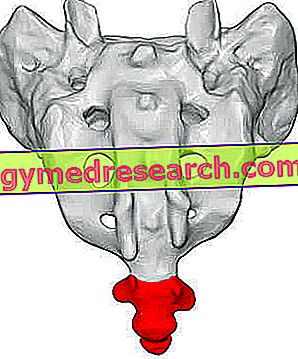Generality
The amygdala is a particular agglomeration of nerve nuclei, which is located in the innermost part of both temporal lobes of the brain.

Morphologically similar to an almond, the amygdala borders on the infero-medial margin, superiorly, the optic tract, laterally, and the hippocampus, posteriorly.
The amygdala covers different functions: it contributes to the limbic system; plays a key role in the formation and memorization of memories associated with emotional events; is responsible for the so-called fear conditioning; participates in the development of emotional states such as fear, anger, happiness, sadness, aggression, etc .; favors the memory of what has caused pain; finally, it is involved in excitement and decision-making processes.
Brief anatomical review of the brain proper
The brain proper, or telencephalon or more simply brain, is the most voluminous and important component of the 4 that make up the brain (NB: the other 3 are the cerebellum, the diencephalon and the brainstem).
Contained within the skull (or neurocranium ), the brain basically consists of two large masses mostly homologous of nervous tissue, called cerebral hemispheres, in the middle of which a deep one flows with anteroposterior direction ( axis or sagittal plane ) separatory groove, called interhemispheric groove . All this, therefore, results in the presence of a cerebral hemisphere to the right of the separator groove ( right cerebral hemisphere ) and of a cerebral hemisphere to the left of the separator groove ( left cerebral hemisphere ).
To conclude this brief review of the brain is a note on the subdivision of the brain into gray substance and white substance .
The gray substance corresponds to the most superficial layers of the cerebral hemispheres and constitutes, to all effects, the lamina of nerve cells which takes the name of cerebral cortex and which forms the so-called lobes of the brain ; the white substance, on the other hand, corresponds to the deeper layers of the cerebral hemispheres and represents, in fact, the base of the aforementioned cerebral cortex.
What is the Amigdala?
The amygdala, or amygdaloid body, is a particular peer region of the brain, home to several nerve nuclei, which belongs to the temporal lobe and takes part in the so-called limbic system .
The amygdala is, therefore, a portion of both hemispheres of the brain (even region), located in the innermost part of the inferior-inferior section of the cerebral cortex (limbic system of the temporal lobe).
Anatomy
Morphologically similar to an almond, the amygdala occupies the most intimate part of the temporal lobe, whose specific name is the medial temporal lobe .
The amygdala is a small brain structure; in fact, in fact, its volume is just over 1.7 centimeters.
Looking at a human head, the amygdala is found approximately at the temple .
Did you know that ...
The word "amygdala" comes from the Greek word "amygdalé" ("ἀμυγδαλή"), which in Italian means "almond".
The amygdala, therefore, bears the name of the fruit to which it resembles.
Structure of the Amigdala: the nuclei
Premise: a nerve nucleus is a dense grouping of neuron bodies with a specific common function (NB: the body of a neuron is the portion of the nerve cell in which the so-called cell nucleus resides).
The amygdala is a cluster of nerve nuclei.
Among the nerve nuclei that make up the amygdala, there are:
- The 3 nuclei of the so-called basolateral complex . To be precise, these 3 nuclei are: the lateral nucleus, the basolateral nucleus and the accessory basal nucleus.
The basolateral complex establishes connections with the cerebral cortex, the thalamus and the hippocampus .

- The cortical nucleus and the medial nucleus . To unite these two nuclei is that both are deputies to receive information from the olfactory system .
- The central core . This nucleus is involved in receiving and processing information relating to pain; moreover, it is connected to the brainstem, with which it participates in the control of innate behaviors and associated physiological responses, and to the hypothalamus, with which it takes part in emotional responses (eg: changes in heart rate following an emotion, etc. .).
- The nucleus of the so-called intercalated cells of the amygdala . According to the most reliable theories, these particular cells would be the "switches" used by the amygdala, at the time of need, the central nucleus and the basolateral complex.
Amygdala and limbic system
As stated in the beginning, the amygdala is a component of the limbic system.
With the term "limbic system", neurologists indicate a complex of brain structures with a key role in emotional reactions, memory processes, behavior and smell.
Did you know that ...
Along with the temporal lobe, the frontal lobe and parietal lobe also participate in the formation of the limbic system.
Like the temporal lobe, the frontal and parietal lobes also take part in the limbic system through their innermost parts.
Proximity reports of the Amigdala
The amygdala borders on:
- The infero-medial margin of the claustro, superiorly.
The claustro is a lamina of gray substance located on the cortex of the insular lobe ; the insular lobe is a portion of the cerebral cortex located deeply within the lateral fissure of Silvio, ie the groove that separates the temporal lobe from the frontal lobe.
- The optic tract, laterally.
The optic tract is a continuation of the optic nerve (one of the 12 cranial nerves), which runs from the optic chiasm to the lateral geniculate body of the thalamus.
- The hippocampus, posteriorly.
The hippocampus is another important region of the medial temporal lobe, which is also part of the limbic system.
Connections of the Amigdala with other structures of the nervous system
Thanks to the projections of its nerve nuclei, the amygdala establishes a series of connections with other structures of the central nervous system of the human being, including: the hypothalamus, the reticular nucleus of the thalamus, the dorso-medial nucleus of the thalamus, the nuclei of the trigeminal nerve and facial nerve, the ventral tegmental area and the locus ceruleus .
Blood circulation of the Amigdala
The amygdala receives the blood necessary to keep it alive and to make it work better from: the anterior corioid artery and the temporal branches of the posterior cerebral artery .
Amygdala: differences between men and women
In men and women, the amygdala is identical except for its size; in fact, in male subjects, it tends to be slightly larger than in female subjects.
According to the experts, this size difference would be due to a more prolonged development of the human amygdala, compared to the woman's amygdala (for which development times are faster).
Function
The amygdala has several functions.
First of all, it plays a key role in the formation and memorization of memories associated with emotional events .
For example, it is thanks to the amygdala that human beings remember childhood traumas and moments of suffering experienced in the past.
Secondly, it is responsible for the so-called fear conditioning, that is the learning process that allows human beings, following repeated experiences, to learn to fear something.
It is thanks to the presence of the amygdala that the human being learns to avoid, out of fear, dangerous and / or frightening situations, capable in some way of undermining a certain balance or even survival.
It is no coincidence that neurologists correlate the amygdala with the so-called survival instinct .

Thirdly, he participates in the development of emotions, such as anger, pleasure, sadness, fear, aggression, a sense of anxiety, etc.
The amygdala is the structure of the brain that, when the human being experiences intense emotion, triggers phenomena such as tachycardia, the release of stress hormones, the increase in pressure, the intense sweating, the increased respiratory rate, anxiety, etc.
Finally, it contributes to the memory of what has caused pain, excitement and decision-making processes .
Curiosity
According to some studies, there would be some functional differences between the amygdala of the right cerebral hemisphere (right amygdala) and the amygdala of the left cerebral hemisphere (left amygdala).
In particular, while the right amygdala would participate exclusively in the processing of negative emotions (such as fear or sadness), the left amygdala would contribute to the processing of all kinds of emotions, from the negative to the positive (eg, pleasure, happiness etc.).
diseases
Recent neurological research suggests that there is a relationship between amygdala hyperactivity and medical conditions, such as anxiety, panic attack, obsessive compulsive disorder, post-traumatic stress disorder, borderline personality disorder, the social anxiety disorder, bipolar disorder and alcohol dependence .
In addition, other recent studies have shown that from the lesions of the amygdala derives an abnormal neglect of the danger (as if the absence of a healthy amygdala prevented one from feeling fear).



